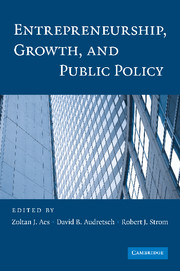Book contents
- Frontmatter
- Contents
- Contributors
- Acknowledgments
- ENTREPRENEURSHIP, GROWTH, AND PUBLIC POLICY
- 1 Introduction: Why Entrepreneurship Matters
- PART I THE ROLE OF ENTREPRENEURSHIP IN INNOVATION
- 2 Capitalism
- 3 Toward a Model of Innovation and Performance Along the Lines of Knight, Keynes, Hayek, and M. Polanyí
- 4 Advance of Total Factor Productivity from Entrepreneurial Innovations
- 5 Silicon Valley, a Chip off the Old Detroit Bloc
- PART II LINKING ENTREPRENEURSHIP TO GROWTH
- PART III POLICY
- Index
- References
2 - Capitalism
Growth Miracle Maker, Growth Saboteur
Published online by Cambridge University Press: 05 June 2012
- Frontmatter
- Contents
- Contributors
- Acknowledgments
- ENTREPRENEURSHIP, GROWTH, AND PUBLIC POLICY
- 1 Introduction: Why Entrepreneurship Matters
- PART I THE ROLE OF ENTREPRENEURSHIP IN INNOVATION
- 2 Capitalism
- 3 Toward a Model of Innovation and Performance Along the Lines of Knight, Keynes, Hayek, and M. Polanyí
- 4 Advance of Total Factor Productivity from Entrepreneurial Innovations
- 5 Silicon Valley, a Chip off the Old Detroit Bloc
- PART II LINKING ENTREPRENEURSHIP TO GROWTH
- PART III POLICY
- Index
- References
Summary
For the general welfare, growth is arguably the most pressing of all economic issues. It is the one process that can raise living standards without letup and promise substantial reduction of the world's widespread poverty, which George Bernard Shaw rightly described as humanity's greatest crime. The pressing issue, then, is what can be done to stimulate economic growth substantially or at least to preclude its decline?
Just a few years ago many of us thought that we had the answer, and that the answer was obvious. When the Soviet empire collapsed it seemed clear that the magic formula was contained in one word: “capitalism.” After all, no small role in the collapse was played by the poverty of the Soviet economy, and its resulting inability to keep up with the West. This, along with envy of the economic miracles that so many capitalist nations had been able to produce, were all obviously attributable to rejection of the capitalist system by the communist regimes, or so it seemed. However, this conclusion is only partly true, and even when true, the story requires some nuance (Schramm 2004). The decade of disappointing economic performance in Russia and the repeated economic crises in Latin America and other such phenomena clearly must give us pause. In our book, Good Capitalism, Bad Capitalism, we offer what we believe to be the explanation. Capitalism is not a homogeneous animal. The term represents a number of species.
- Type
- Chapter
- Information
- Entrepreneurship, Growth, and Public Policy , pp. 17 - 34Publisher: Cambridge University PressPrint publication year: 2009
References
- 11
- Cited by



